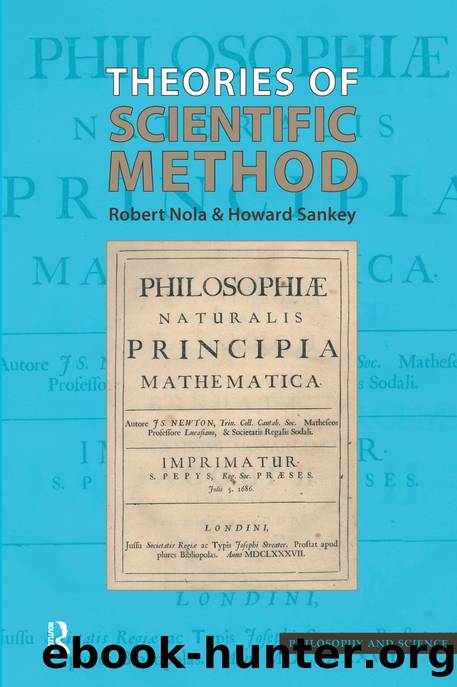Theories of Scientific Method by Nola Robert. Sankey Howard. & Howard Sankey

Author:Nola, Robert.,Sankey, Howard. & Howard Sankey [Robert Nola]
Language: eng
Format: epub
ISBN: 9781317493488
Publisher: Taylor & Francis (CAM)
There is also a form of the total probability principle for conditional probabilities that, under partitioning by rivals H and ¬H, is as follows: P(E, B) = P(H, B)P(E, H & B) + P(¬H, B)P(E, ¬H & B) Axiom 3 provides an addition principle for the probability of disjoined hypotheses in terms of the addition of the probabilities of each disjunction. There is also a rule for the probability of conjoined hypotheses in terms of the multiplication of probabilities of each conjunct. In a simple form it says: Multiplication or conjunction principle: P(Hl & H2) = P(H1) x P(H2), where Hl and H2 are independent of one another. To illustrate, suppose a pair of fair dice is rolled; since the rolling of each die is independent of the rolling of the other the principle applies. If Hl = "die 1 produces a 6" (so P(H1) = 1/6) and H2 = "die 2 produces a 6" (so P(H2) = 1/6), then by the principle the probability that a pair of sixes is rolled is P(Hl & H2) = 1/6 x 1/6 = 1/36. The rule also provides a condition for the probabilistic independence of Hl and H2 from one another.
Expressed as conditional probabilities the corresponding principle says that the probability of the conjunction of two hypotheses, given evidence, is equal to the probability of the first hypothesis given the same evidence multiplied by the probability of the second hypothesis given that the same evidence and the first hypothesis is true: P([H1 & H2], E) = P(H1, E) x P(H2, [E & H1]) Put more generally we can express the multiplication principle as follows: P(H & E, F) = P(E, F) x P(H, E & F) = P(H, F) x P(E, H & F) We shall not explore the principle further, except to note that if we consider "F" to be a tautology we can effectively eliminate expression "F" and arrive at a special case of the multiplication principle, which, rearranged, is the definition of conditional probability in terms of unconditional probability: P(H & E) = P(H, E) x P(E) This is important in that it leads directly to a form of Bayes's theorem. The proof is simple, and depends also on the equivalence principle and the definition of conditional probability (a special case of the multiplication principle). (1) P(H & E) = P(E & H) [by equivalence principle] (2) P(H, E) x P(E) = P(E, H) x P(H) This is obtained by two substitutions in (1), one for the left and one for the right, of the definition of conditional probability as expressed just above, observing carefully the order of H and E in (1). By suitable rearrangement we get the first simple form of Bayes's theorem: (3) P(H, E) = P(E, H) x P(H)/P(E), providing P(E) â 0
A paper by Thomas Bayes (1702-61) on probability was published posthumously in 1763. Although the exact form of (3), which we now commonly call Bayes's theorem, is not to be explicitly found in
Download
This site does not store any files on its server. We only index and link to content provided by other sites. Please contact the content providers to delete copyright contents if any and email us, we'll remove relevant links or contents immediately.
| Electron Microscopes & Microscopy | Experiments & Projects |
| Measurement | Microscopes & Microsocopy |
| Scientific Instruments | Telescopes |
| Time | Methodology & Statistics |
Hands-On Genetic Algorithms with Python by Eyal Wirsansky (2020) by Unknown(4050)
Thing Explainer by Randall Munroe(3873)
The Elements by Theodore Gray(2994)
The Meaning of it All by Richard Feynman(2297)
Make by Mike Westerfield(2287)
Every Tool's a Hammer by Adam Savage(1886)
Science Experiments You Can Eat by Vicki Cobb(1838)
The Perfectionists by Sara Shepard(1781)
Martin Gardner's Science Magic by Martin Gardner(1685)
Raspberry Pi Electronics Projects for the Evil Genius (Tab) by Norris Donald & Norris Donald(1672)
Elephants on Acid by Boese Alex(1565)
Elephants on Acid: And Other Bizarre Experiments by Alex Boese(1563)
The Perfectionists by Simon Winchester(1555)
Handbook of Modern Sensors by Jacob Fraden(1541)
Synchrotron Light Sources and Free-Electron Lasers by Eberhard J. Jaeschke Shaukat Khan Jochen R. Schneider & Jerome B. Hastings(1522)
Tesla by Carlson W. Bernard(1484)
The Science of Food by Marty Jopson(1447)
The Meaning Of It All by Richard P. Feynman(1420)
125 Physics Projects for the Evil Genius by Silver Jerry(1416)
